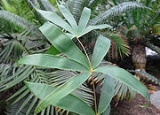
Ceratozamia hildae
Encyclopedia
Ceratozamia hildae, commonly known as the Bamboo Cycad, is a species of cycad
in the Zamiaceae
family that is endemic to Mexico
. It is native to the Huasteca Potosina of Querétaro
and San Luis Potosí
, near the Santa Maria River
. C. hildae inhabits deciduous oak woodlands
at elevations of 850–1300 m (2,788.7–4,265.1 ft). It is threatened by habitat loss and over-collecting.
Cycad
Cycads are seed plants typically characterized by a stout and woody trunk with a crown of large, hard and stiff, evergreen leaves. They usually have pinnate leaves. The individual plants are either all male or all female . Cycads vary in size from having a trunk that is only a few centimeters...
in the Zamiaceae
Zamiaceae
The Zamiaceae are a family of cycads that are superficially palm or fern-like. They are divided into two subfamilies with eight genera and about 150 species in the tropical and warm temperate regions of Africa, Australia and North and South America....
family that is endemic to Mexico
Mexico
The United Mexican States , commonly known as Mexico , is a federal constitutional republic in North America. It is bordered on the north by the United States; on the south and west by the Pacific Ocean; on the southeast by Guatemala, Belize, and the Caribbean Sea; and on the east by the Gulf of...
. It is native to the Huasteca Potosina of Querétaro
Querétaro
Querétaro officially Estado Libre y Soberano de Querétaro de Arteaga is one of the 31 states which, with the Federal District, comprise the 32 Federal Entities of Mexico. It is divided into 18 municipalities and its capital city is Santiago de Querétaro....
and San Luis Potosí
San Luis Potosí
San Luis Potosí officially Estado Libre y Soberano de San Luis Potosí is one of the 31 states which, with the Federal District, comprise the 32 Federal Entities of Mexico. It is divided in 58 municipalities and its capital city is San Luis Potosí....
, near the Santa Maria River
Santa Maria River (San Luis Potosi)
-References:*Atlas of Mexico, 1975 .*The Prentice Hall American World Atlas, 1984.*Rand McNally, The New International Atlas, 1993....
. C. hildae inhabits deciduous oak woodlands
Sierra Madre Oriental pine-oak forests
The Sierra Madre Oriental pine-oak forests are a subtropical coniferous forest ecoregion of northeastern and Central Mexico, extending into the state of Texas in the United States.-Setting:...
at elevations of 850–1300 m (2,788.7–4,265.1 ft). It is threatened by habitat loss and over-collecting.

